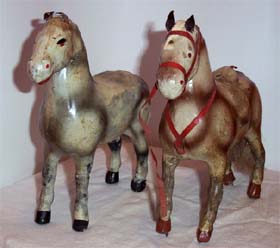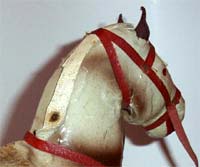Vintage Papier Mache Toys
Not only dolls were made from papier mache, but also other toys. These toys were made in moulds. Early moulds would have been made out of wood or fired clay, which were either lacquered or greased. After a lot of use there was no need to grease the moulds as enough protective grease remained.
To make the toys, glued paper was pasted right round the mould until it was covered. After drying, it was cut in two and the two halves glued back together. They were then decorated with either paint or paper.
Later toys were made in plaster moulds in two sections. This time the inside had soaked layers of paper pressed into it. The two halves would again be joined and hand decorated. Newspaper was mostly used, or sometimes cardboard.
The glue used was flour and water mixed with tragacanth gum. Toys were usually varnished to offer protection and enhance the appearance.
Papier Mache toys are most familiar in parts of Asia. It is thought that toy making didn’t begin in Europe until the 19th Century although earlier examples have been known.
European toys (apart from dolls) were mostly animals. Horses (often pulling carts or on wheeled bases as pull along toys), dogs, and bears were common. Some early toys were coated with flock powder. An example of this was the well-known “Barking Bulldogs” of the 1890’s. These dogs had hidden wheels in their feet.
Some toys were obviously still made as late as the 1920’s but this was very rare. A commercial formula of a company used as its recipe (according to the excellent resource book “Henley’s 20th Century Formula’s, Recipes and Processors”) – “wet paper pulp, dry plaster of paris and hot glue”. So the good old-fashioned ingredients hadn’t altered much over time!
The life of papier mache toys in Europe was fairly short lived. They soon realised that they were not robust enough and turned to other stronger materials such as composition and wood.
Children during World War 2 found great enjoyment making their own toys from papier mache. With a shortage of toys, they often made puppets to play with.
Papier Mache Horses

- Papier Mache horses
I have two old papier mache horses in my collection. They each stand 9” high by about the same lenghways. They are classic examples of toys made in two moulds and glued together. Each of them has a piece of metal protruding from each hoof, so I assume that at some time they were fixed to a wooden base with wheels and were pull-along toys. The tails are made of horsehair which was common with these sorts of toys.
The saddles and bridles were often nailed onto the horse (ouch!). In this close-up photo you can see one of the nails.

- Close up of nail
I believe these horses to be quite old – possibly around 1890 but it is difficult to date them, as like a lot of papier mache there is no mark. If you know anything about them please me – I’d love to hear from you! Also, if you have an old papier mache toy you would like to share with others, send me an email and we will see if we can add them to the site.

